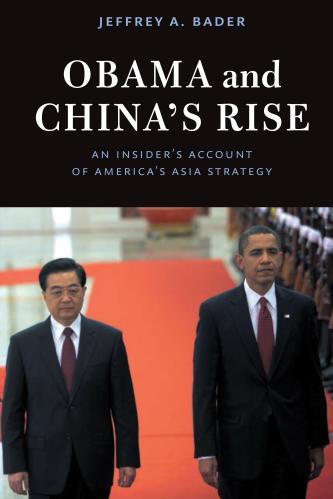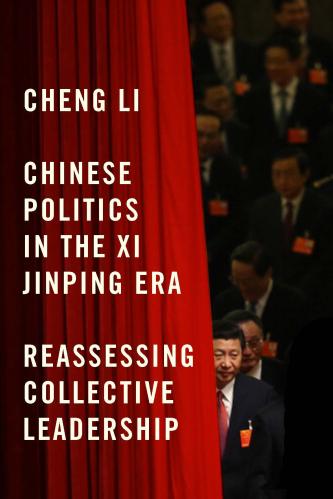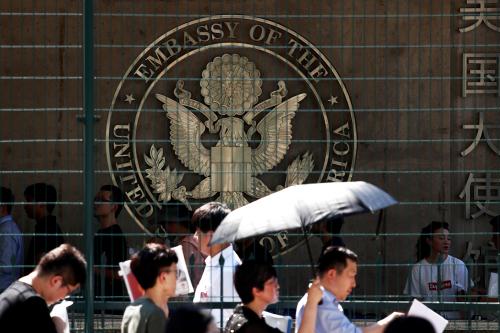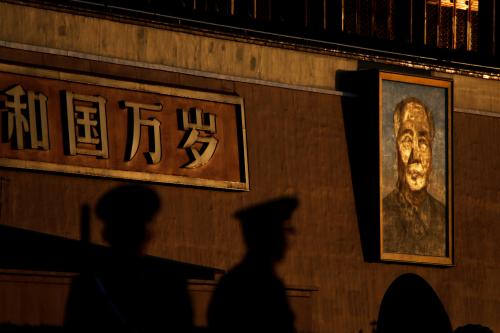On Saturday, June 3, 1989, I was at my State Department desk, where I worked as acting director of the Office of Chinese and Mongolian Affairs. There had been no Saturdays off since demonstrations in Beijing’s Tiananmen Square began in the wake of the April 15 death of the pro-reform former General Secretary of the Communist Party Hu Yaobang. I was preparing to leave the office near mid-day Washington-time when the first reports came in—shortly before it struck June 4 in Beijing—that units of the People’s Liberation Army (PLA) were heading towards Tiananmen.
In the seven weeks after Hu’s death, the demonstrations had grown into the largest in modern Chinese history, culminating in marches and encampments of young people numbering in the millions. The student leaders of the demonstrations regarded Hu as a martyr and made demands denouncing official corruption, aiming to bring democracy as they conceived it to China. The Beijing demonstrations inspired imitators in China’s other major cities, notably in Shanghai, where the Party secretary, Jiang Zemin, struggled to keep a lid on the situation without calling in the military.
China was descending deeper into a crisis whose outcome was uncertain. The previous month had exposed to the world a sharp split within the Chinese Communist Party (CCP) leadership. Hard-liners led by Premier Li Peng argued for a forceful end to the demonstrations, which they saw as a threat to the survival of the Communist Party. On the other side, the party’s General Secretary Zhao Ziyang sought accommodation with the protesters, fearing the impact of repression on China’s unity and the reform project he advocated. The military leadership was divided, not necessarily sympathetic with the demonstrators’ demands but reluctant to play the role of domestic police force in a divided country. The People’s Daily, normally a consistent and predictable voice for the deadening propaganda of the party leadership, had become a forum for what Chinese called a “two-line struggle,” with opinion pieces and reporting on the front page reflecting the contending forces.
Missing from the public conversation was China’s true leader: Chairman of the Central Military Commission Deng Xiaoping. Under Deng, China had radically transformed in the last decade—the beginning of economic modernization and movement toward a market economy, integration into the international order, and tolerance, though not support, for elite discussion of fresh ideas for political governance. Deng was, however, a strong supporter of the rule of the Communist Party and the author of the so-called “Four Principles,” the core of which was the party’s monopoly on political power.
An unsigned editorial in the People’s Daily on April 26 denounced the demonstrations as “counterrevolutionary,” which in Communist jargon meant treasonous. Only a small circle knew the author’s identity: It was Deng himself. Deng saw the student demonstrations as a reprise of the Red Guard violence of the Cultural Revolution, which had wrecked the party, the country, and him personally. Deng’s editorial had enraged Beijing’s students, and demands for its retraction became their rallying cry.
On May 15, Soviet leader Mikhail Gorbachev arrived in Beijing for a historic visit, the first by a Soviet leader to China since the Sino-Soviet split in the 1960s. It was a catastrophe. Enormous demonstrations forced the cancellation of the arrival ceremony and left Gorbachev’s schedule in shambles. The humiliation of the Chinese leadership was resounding. Upon Gorbachev’s departure, an expanded Politburo Standing Committee meeting, headed by Deng, overruled Zhao Ziyang, declared martial law, and demanded an end to the demonstrations. Zhao was ousted as general secretary, to be succeeded several weeks later by Jiang Zemin.
After martial law was declared, the demonstrations seemed to peter out. But a week later they restarted with renewed momentum, reinforced by participants from outside Beijing prepared for a long resistance. The party leadership’s already deep suspicion of the origins and motives of the demonstrators was exacerbated by the appearance of a papier-mâché “Goddess of Democracy,” bearing a striking resemblance to the Statue of Liberty.
Night of Repression
On June 3 to 4, the 27th Army of the PLA cleared out the demonstrations west of and in Tiananmen Square using lethal force. Beijing has never provided a credible accounting of the dead, asserting shortly thereafter that about 300 people were killed. The New York Times estimated deaths at close to 1,000, based on journalist visits to hospitals. Whatever the number, the killings were a shock to China and to the watching world, which had not seen such bloodshed inside China since the Cultural Revolution.
U.S. officials from across the foreign affairs community gathered at the State Department on the afternoon of June 3 to discuss options in response. A consensus formed for suspending high-level visits and exchanges, suspending military cooperation with China, and opposing most loans to China by the World Bank and Asian Development Bank. There was brief discussion of China’s Most Favored Nation (MFN) trade status, but no support for denying it. In fact, the State Department had only days earlier sent an annual waiver to the Congress under the Jackson-Vanik law that assured China’s continued MFN eligibility, enabling Chinese goods to continue to enter the United States at the same tariff levels as those of other countries. The meeting’s mood was that the United States had to respond to the massacre with measures that had teeth, but it was imperative not to take steps that might drive China back towards isolation, autarky, and hostility.
Based on what I heard at the meeting, I drafted a memorandum to President George H.W. Bush laying out these steps. I coordinated closely with National Security Council Asia Senior Director Doug Paal, who had excellent access to the thinking of top White House officials. President Bush quickly approved the recommendations.
U.S. Government follow-up: Saving lives and keeping doors open
In the coming months, I was involved in a number of decisions designed to prevent the relationship from going into free fall, including: approving waivers permitting the sale of aircraft navigation systems, without which Boeing’s China market would have evaporated; a visit later in the year by National Security Advisor Brent Scowcroft and Deputy Secretary of State Lawrence Eagleburger to Beijing to restore high-level communication; and a presidential veto of legislation that would have provided asylum to all Chinese students in the U.S. (their status was instead protected by an executive order with the same content, the goal being to ensure the president retained control over China policy).
On the other hand, I worked with U.S. embassy officials and security agencies to provide refuge for Chinese dissidents threatened by the expanding crackdown, most prominently the astrophysicist and vocal political reform advocate Fang Lizhi. On June 5, I received a call from the acting political counselor in Beijing, saying Fang and his family had come to the embassy seeking asylum but had been turned away. Using language not suitable for this website, I told the embassy to reverse the decision and bring Fang and his family back to the embassy—fortunately, the president supported that decision, too. Thanks to the savvy of embassy political officer Jim Keith, they were smuggled into the embassy in the back of a van that night. We spent the next year negotiating their departure from China. There were numerous others whose escape abroad or to Hong Kong we helped to engineer with less visibility.
Consequences for China
The consequences of June 4 were far-reaching, though not altogether what many experts and officials predicted.
After a brief economic downturn caused by China’s international isolation, Deng signaled China’s redoubled commitment to economic reform with a well-publicized visit to southern China. A two-decade era of double-digit economic growth ensued, making China the so-called “factory of the world.” The Communist Party did not collapse, like the parties in all countries in Eastern Europe, and it tightened its grip on power. Relying on the troika of effective repression by its security agencies, spectacular economic growth, and a nationalism that asserted that only socialism could save China, the party since then has endured no challenges of the magnitude it faced in the preceding 40 years. The principal lesson that party leadership learned was that it could not tolerate division, especially publicly, since it invited popular uprisings and chaos.
June 4 did not interrupt China’s rise to great-power status. In that trajectory, what happened in Tiananmen Square turned out to be no more than a hiccup. But the damage it has done to China has been substantial. It effectively ended a decade of intellectual ferment about the future of China’s governance, with the idea of political reform taken off the agenda. A veil of silence has descended over June 4, with no public discussion tolerated and websites rigorously scrubbed to prevent its mention.
The governments of many countries committed atrocities in the 20th century, and few have performed adequate penance, but almost all—Germany, Japan, the United States, Rwanda, South Africa, Argentina, Israel, to name a few—have engaged in examination and reflection. In China, that has not happened with regard to June 4. China’s rise in itself causes anxieties among foreigners, but a rise devoid of self-reflection, honesty about its history, and rectification of a grievous past event heightens concerns.
China’s rise in itself causes anxieties among foreigners, but a rise devoid of self-reflection, honesty about its history, and rectification of a grievous past event heightens concerns.
For those of us who had worked on China for decades, it was not a revelation that the Chinese Communist Party, if threatened, was capable of repression and bloodshed. Our two most senior China intelligence analysts, Bob Suettinger and Dennis Wilder, were not caught by surprise by the way events unfolded in 1989, and I relied heavily on their expert guidance and my own experience. I had never seen China as an incipient candidate for regime change either before or after June 4, and argued with colleagues who thought the fall of the Iron Curtain meant that the collapse of the CCP was imminent.
But June 4 left a long-term stain on U.S.-China relations. It shattered the illusion that China, if not on the road to multi-party democracy, was at least open to party-led political reform. It ensured that movements with political overtones outside the party would invariably be seen as threatening and subject to disbandment. It contradicted the belief of some China-watchers that China’s leaders were capable of maintaining stability without overt and forceful repression. It ushered in nearly a decade of tense relations and frequent confrontation between the United States and China that finally abated, but as we have seen in the last two years the truce was only temporary.
For years, U.S. officials called on China to provide an accounting of the fatalities on June 4. The CCP ignored such calls as interference in their internal affairs. U.S. calls for candor about Tiananmen have grown softer as time has passed. But the Chinese leadership will be doing itself a great favor if one day it opens its archives and provides a full accounting, and reflection. Such a decision probably won’t occur until and unless the prospects improve for broader political reform in China. In the current climate, it seems a dim possibility. If and when it finally happens, it will not be a concession to foreign critics, but an act of revelation demanded by people in China who want to build a future China based on honest assessment of its past wounds.
The Brookings Institution is committed to quality, independence, and impact.
We are supported by a diverse array of funders. In line with our values and policies, each Brookings publication represents the sole views of its author(s).









Commentary
June 4, 1989: A personal recollection
Looking back on Tiananmen
May 29, 2019